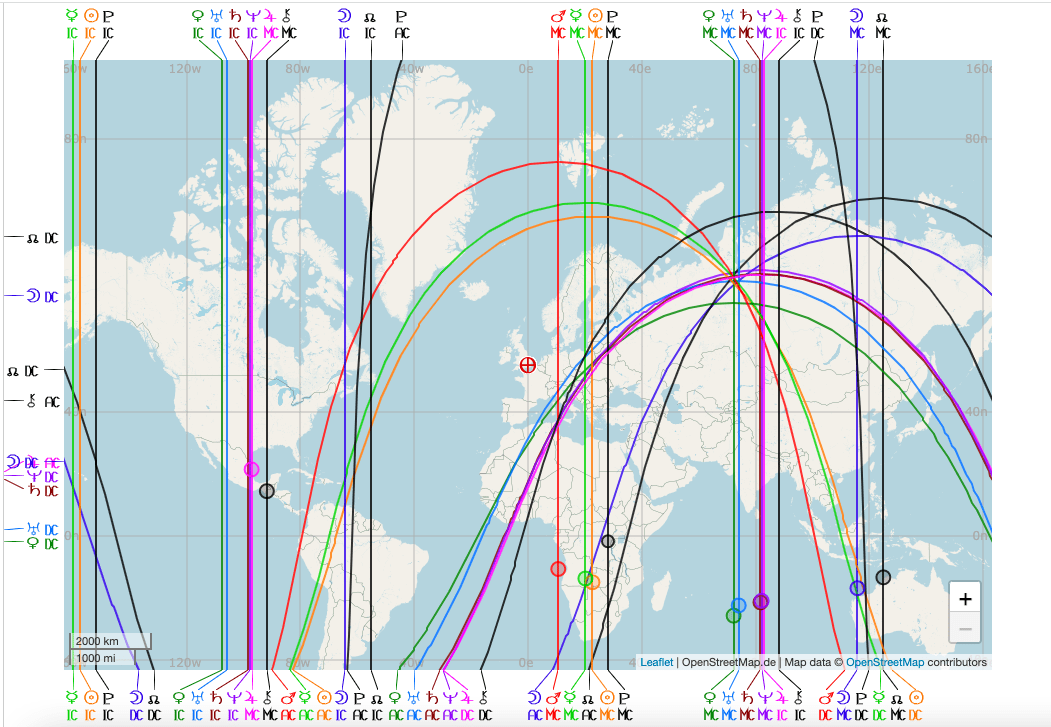Understanding Astrocartography Chart: A Comprehensive Guide
Astrocartography chart is a fascinating tool that combines astrology with geography, allowing individuals to explore how different locations on Earth may influence their life experiences. This unique aspect of astrology provides insights into where you might thrive personally and professionally based on your natal chart. In this article, we will delve deep into the concept of astrocartography, explaining its significance, how to read your own astrocartography chart, and the benefits it can bring to your life.
As we journey through this article, we will examine the core principles of astrocartography, including its history, methodology, and practical applications. By the end, you will have a better understanding of how to utilize your astrocartography chart to make informed decisions about where to live, work, or travel. Whether you are a seasoned astrologer or a curious beginner, this guide aims to be an invaluable resource for anyone interested in the intersection of astrology and geography.
So, let's embark on this enlightening exploration of astrocartography and uncover the hidden potentials of your personal chart.
Table of Contents
- What is Astrocartography?
- History of Astrocartography
- How to Read an Astrocartography Chart
- Components of an Astrocartography Chart
- Benefits of Astrocartography
- Practical Applications of Astrocartography
- Case Studies: Real Life Examples
- Conclusion
What is Astrocartography?
Astrocartography is a specialized branch of astrology that maps the positions of celestial bodies at the time of an individual's birth onto a geographical map of the Earth. This technique reveals how different locations can affect personal experiences and life events. Each line on an astrocartography chart represents a different planetary influence, indicating areas where an individual may experience heightened energy, challenges, or opportunities.
History of Astrocartography
The concept of astrocartography was popularized in the late 20th century by astrologer Jim Lewis. He introduced the method as a way to visually represent how astrological influences vary across different geographic locations. Lewis's work has paved the way for a broader understanding of astrology as it relates to the physical world, allowing people to make more informed choices based on their astrological profiles.
How to Read an Astrocartography Chart
Reading an astrocartography chart involves understanding the various lines that represent different planets and their influences. Here’s a guide on how to interpret your astrocartography chart:
- Sun Line: Indicates areas where you may experience personal growth and recognition.
- Moon Line: Suggests locations where you may feel emotionally connected and nurtured.
- Mercury Line: Represents places that favor communication, learning, and business dealings.
- Venus Line: Points to areas associated with love, beauty, and harmony.
- Mars Line: Shows places where you may feel energized and assertive.
Steps to Analyze Your Chart
- Obtain your natal chart and astrocartography map.
- Identify the planetary lines and their corresponding influences.
- Consider the locations that fall under these lines and reflect on your experiences in those areas.
Components of an Astrocartography Chart
An astrocartography chart consists of several key components that provide insights into your astrological influences:
- Lines: Each line represents a different planet, indicating its influence in that geographic location.
- Houses: The astrological houses in your natal chart can also affect how you experience different locations.
- Aspects: The relationships between planets in your natal chart can modify the effects of the planetary lines.
Benefits of Astrocartography
Utilizing astrocartography can offer various benefits, including:
- Identifying ideal locations for personal growth and career advancement.
- Understanding emotional responses to different places.
- Making informed travel plans to enhance relationships and opportunities.
Practical Applications of Astrocartography
Astrocartography can be applied in numerous practical ways:
- Choosing a Place to Live: Use your chart to find locations that align with your personal goals.
- Travel Planning: Identify destinations that may enhance your experiences during a trip.
- Career Decisions: Discover where you might find the most professional success.
Case Studies: Real Life Examples
Examining real-life examples can illustrate the impact of astrocartography:
- Example 1: A person with a strong Venus line in Paris may find love and artistic inspiration in that city.
- Example 2: An individual with a prominent Mars line in New York might experience increased energy and ambition in their career endeavors.
Conclusion
In summary, the astrocartography chart is a powerful tool that can provide insights into how different locations may influence your life experiences. By understanding the various planetary lines and their meanings, you can make informed decisions about where to live, work, or travel. We encourage you to explore your own astrocartography chart and see how it can benefit your life.
If you found this article helpful, please leave a comment below, share it with friends, or check out our other articles on astrology and personal development.
Thank you for reading! We hope you return for more insightful content on astrology and related topics.
Exploring The Life And Career Of Anne Hathaway: A Journey Through Hollywood
Discovering Rain Mancini: The Rising Star Of The Entertainment Industry
Tony Hawk: The Legend Of Skateboarding


